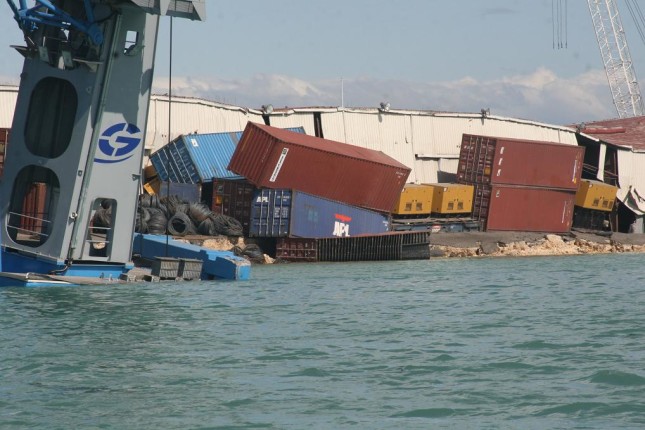-
Disaster Relief Law Updated to Enhance Resilience of Critical Infrastructure
January 16, 2019 By Ladeene Freimuth
Until recently, if a natural disaster destroyed or damaged critical infrastructure, U.S. disaster relief law generally required it to be replaced or rebuilt in a “substantially similar” manner. This requirement made no sense for several reasons. In some cases, old, outdated infrastructure no longer exists, so replacing it in the same manner would be difficult, if not impossible.
Perpetuating Vulnerability
What’s more, repairing or replacing infrastructure in “substantially the same manner” will not reduce chronic vulnerability or mitigate the impacts of future storms. The outdated law led to increased costs and loss of life, rather than stopping or reversing this cycle by boosting resilience, which USAID defines as “the ability of people, households, communities, countries, and systems to mitigate, adapt to, and recover from shocks and stresses in a manner that reduces chronic vulnerability and facilitates inclusive growth.” Given the impacts of hurricanes, wildfires, and other extreme events, and the potential for more devastation from these sources in the future, this requirement no longer made sense and needed to be changed.
Fortunately, language in bipartisan legislation entitled the Disaster Recovery Reform Act (DRRA) was enacted into law late last year to change this situation. Specifically, the Act changes the underlying law to make it possible to rebuild damaged or destroyed infrastructure in a more resilient manner, following future disasters. This latest legislative change “is vitally important to protect against and mitigate potential destruction from future disasters,” said Steve Hauser, CEO of the GridWise Alliance.
Enhancing Infrastructure Resilience
The latest research shows that society saves $6 for every $1 invested in mitigation (6:1 benefit-cost ratio). The Act recognizes these tremendous financial benefits by taking proactive, mitigation- and adaptation-oriented approaches.
This change in the law means that, rather than restoring an electric system that has been damaged or destroyed by a disaster back to the way it previously existed, instead, it now can be rebuilt using technologies and capabilities that will be better able to withstand future damage. This more resilient approach could involve using more geographically distributed, clean energy resources or microgrids that can operate in isolation from the larger electric grid and serve as alternate power sources.
As another example, equipment could be replaced or upgraded with digital technologies that enable outages or other problems to be remotely and more readily detected and isolated. In many instances, power could be re-routed, thereby minimizing the number of customers affected and likely also shortening power outage durations. This policy change will enhance the resilience, reliability, and security of hospitals, nursing homes, and other critical facilities. The new law also applies retroactively and allows for more resilient rebuilding of damaged or destroyed infrastructure following the hurricanes of 2017. These vital new changes in the law are timely and long overdue.
Globally, weather-related events in 2017 resulted in $344 billion in financial losses, which is 93 percent higher than the average yearly losses between 2000 and 2016. With extreme weather events expected to increasingly disrupt our energy and transportation systems, the recent Fourth National Climate Assessment underscores the likelihood for “cascading impacts on other critical sectors.” Given that CNA’s Military Advisory Board has identified climate change as a “threat multiplier,” security implications also may follow.
Highlighting the “Responsibility to Prepare”
Unprecedented risks also offer unprecedented foresight and opportunity. This change in domestic law is one major step forward. However, more needs to be done to enhance resilience from the community to the global levels including, for instance, through the global “Responsibility to Prepare” framework. Climate change should be incorporated into security-related strategic planning efforts at the front end. Enhancing resilience and preparing for this changed future also will require greater individual and collective political will and leadership and innovative, collaborative, and cross-cutting approaches.
Ladeene Freimuth is a Wilson Center Global Fellow and President of The Freimuth Group, a domestic and global energy and environmental consulting firm. She previously worked in the U.S. House, Senate, Executive Branch, and private sector. Overseas, she worked on global women’s and transboundary water management projects.
Sources: Aon, CNA Corporation, Center for Climate and Security, Congress.gov, GridWise Alliance, Government Printing Office, National Institute of Building Sciences, U.S. Global Change Research Program, USAID
Photo Credit: Damage to the Port-au-Prince port following the 2010 earthquake. U.S. Coast Guard personnel arrived in Haiti to assess damage to the ports and waterways after an earthquake ravaged the island Jan. 12, 2010. U.S. Coast Guard photo.
 A Publication of the Stimson Center.
A Publication of the Stimson Center.



